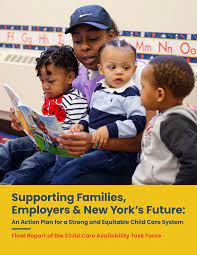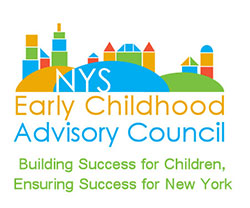 Name of Initiative: Child Care Availability Task Force (CCATF)
Name of Initiative: Child Care Availability Task Force (CCATF)
Interview with: Kristen Kerr, Executive Director of the NY Association for the Education of Young Children (NYAEYC) & Meredith Chimento, Executive Director of the Early Care & Learning Council (ECLC).
Regions served: New York State
Populations served: Families with young children (birth to school aged) children in NYS.
Funding: New York State
About the Child Care Availability Task Force:
Vision statement: The members of the Child Care Availability Task Force propose a new vision for making New York State the best place in the nation to raise a family, with a plan to ensure access to high-quality affordable child care for all families of infants, toddlers, and other young (including school-aged) children, and prioritizing the very communities that have been historically underserved. The Task Force’s conclusions are rooted in the explicit recognition that growing our state’s economy — and doing so equitably — requires a dramatically different approach to child care: one that recognizes that high quality child care is a public good and that provides the necessary public investment and expanded access based on that understanding.
Contact:
Meredith Chimento: mchimento@me.com, 518-690-4217 ext. 27
Kristen Kerr: kkerr@nyaeyc.org, 518-867-3517 ext. 302
Website: https://ports/childcare/Child-Care-Availability-Task-Force-Report.pdff

Interview:
The Child Care Availability Task Force (CCATF), introduced by the State Legislature and signed into legislation by the Governor, brought together child care stakeholders from state and local levels. Members of the Task Force were selected based on their expertise connecting policy to practice and broken up into work groups based on their experience. The four workgroups included: Child Care Affordability, Equitable Access to Child Care, High Quality Child Care and Coordinated Systems. Meredith Chimento, who served on the CCATF as well as being an active ECAC Member & the Executive Director of the Early Care & Learning Council (ECLC) states that “We began by developing a literature review which was critical to assess what is occurring around the country and to review best practices from around the world. This was an essential steps for all of the workgroups to define our North Star around what a universal Child Care system should look like in New York State.” The Task Force identified compensation of the workforce as being foundational for all 16 of the recommendations. Kristen Kerr, Executive Director of the New York Association for the Education of Young Children (NYAEYC), also an active ECAC Member who served on the CCATF explains that “We came to our final recommendations fairly unanimously. These recommendations are not necessarily new, but the taskforce gave us the opportunity to bring both private sector stakeholders and public stakeholders together to co-create a vision of what those recommendations should look like and how they should be implemented.”
The work of the CCATF and the ECAC is intertwined and collaborative. Meredith explains that “though the CCATF specifically focused on child care, the recommendations intersect with all of the work that the ECAC does and that is something we highlighted: anything we do to strengthen the services that children receive improves the conditions of all areas of the ECAC. Strengthening child care shapes our children’s futures.” Kristen elaborates on the importance of this partnership: “This is an opportunity here to really sink our feet into the systems building work. When developing these recommendations we worked really hard not only to talk about compensation but also the infrastructure and supports necessary to help our workforce excel in their role as caretakers and educators. In order to deliver on the promise of quality child care there is a whole infrastructure of supports that is necessary. That is something that the ECAC is paying a lot of attention to and doing a lot of work in, so being able to bring that ECAC perspective there was helpful and important. Everyone is paying attention to child care in a new way, and I think that this idea of child care as a part of our infrastructure is finally hitting home.”
Race Equity
Both the CCATF and the ECAC identify race equity as central to the work. Meredith outlines this commitment: “I was so impressed by the way the members of the Task Force felt the need to elevate racial disparities and inequities in access to care and in the discrepancies of wages for women of color in the workforce. We also know that black and brown boys are expelled and suspended at a greater rate from early child hood programs than their white counterparts. I am proud of the work that is being prioritized across the state by the ECAC, the Task Force and all of our partners to elevate this and to come up with ways to address it. Pyramid Model, Adverse Childhood Experiences (ACEs), Infant Toddler Mental Health consultation are all examples of resources, systems and trainings early childhood professionals can use to address challenges in the classroom. We were intentional in centering all of the recommendations on race equity, it was a part of the conversation at all times.”
Kristen expands on this commitment outlining the role of data in race equity work: “It is profoundly true that the entities working on the systems level change in our field, including the ECAC and CCATF, hold the principle intent to address racial and social disparities by creating greater equity in our systems. Policy is often created at the 30,000 foot level and it can be very difficult to predict the full impact or all unintended consequences of policies at the implementation level. Both the ECAC & CCATF have highlighted the need for utilizing data more effectively. The ECAC’s work to develop a comprehensive early childhood data system, will position New York to be better able to measure the impact of policies in meeting their intended goals; including our progress toward creating a more equitable system for all children and families. This project is supporting each program’s use of Alliance Core, a child care management system (CCMS), to assist programs in automating several tasks that many providers and administrators currently do manually. For example, these systems help to facilitate the enrollment process, efficiently track and automate tuition collection, and improve compliance with regulations through automatic reminders, etc. This too takes the burden off of program staff and allows them to focus on pedagogy and family engagement. It’s exciting.”
In order to address systemic inequities in our early childhood system we need to focus on funding. Meredith addresses the question of how we prioritize these recommendations with limited resources: “Supporting our providers and families at a systems level is essential. What we are really focusing on is inequities for women of color in the workforce. How do we prioritize our resources? How can we move together uniformly prioritizing what is necessary?” Operationalizing these recommendations will take increased federal investment. Kristen explains that “the NYS Legislature actually used the increased federal funding, provided to address the impact of the pandemic, to begin to enact some of the CCATF recommendations through this year’s budget. Not only has this helped us address some of the immediate impact of the pandemic, it also positions us well to begin to enact transformational change in how we finance the child care system. These incremental steps and policy decisions help move us closer to our North Star.” Meredith elaborates, stating that “we need to take the recommendations and use them to leverage state and federal investments to create long term change. The pandemic did elevate the need for affordable quality child care across the country and attention was brought to the fact that it is a deficit driven business and that the state recognizes that there are changes that need to be made.” Kristen highlights the need for increased state funding in addition to federal investments: “we have to be crystal clear that increased federal funding alone is not going to get the job done, there has to be increased state investment as well, and as an advisory body, we can’t go forward without saying that very loudly and clearly.”
Current Legislation
Chapter 797 of the Laws of 2021, which was signed into law in December 2021, extended the CCATF through December of 2023 and made changes to the composition and mission of the CCATF. These changes included adding that there be adequate “racial and ethnic” and geographic representation on the CCATF, and expanding the CCATF members to include more home-based child care and center-based child care providers, as well as including one parent who has utilized unsubsidized child care. This law also added to CCATF responsibilities to require that an examination of how child care has been affected by the implementation of policies supported by federal stimulus packages and called on the CCATF to report on implementation of recommendations resulting from the prior CCATF report.
Now, another bill (S.B. 7847/A.B. 8740) to expand the scope of issues examined by the CCATF is before the Legislature. This bill calls upon the CCATF to pivot its focus to evaluate the impact of COVID-19 on the child care industry and identify solutions and partnerships to address workforce issues that plague the provider community. In addition, this bill calls on the CCATF to advise the state in developing an implementation framework leading to a phased-in universal child care plan using existing state and federal funds. As of January 20, 2022, this bill has passed the Senate and currently is with the Assembly Committee on Children and Families.
Meredith Chimento outlines the promise of this pending legislation: “What I am most excited about is this legislation provides us short term opportunities to enact long term change.” Kristen Kerr shares that this legislation represents “a powerful step on the road to transformational change.”
